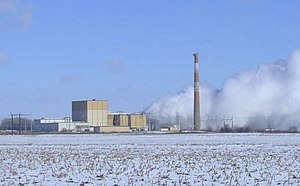| Duane Arnold Energy Center | |
|---|---|
 DAEC in winter | |
 | |
| Country | United States |
| Location | Fayette Township, Linn County, near Palo, Iowa |
| Coordinates | 42°6′2″N 91°46′38″W / 42.10056°N 91.77722°W |
| Status | Being decommissioned |
| Construction began | May 22, 1970 |
| Commission date | February 1, 1975 |
| Decommission date |
|
| Construction cost | $1.165 billion (2007 USD)[1] |
| Owners |
|
| Operator | NextEra Energy Resources |
| Nuclear power station | |
| Reactor type | BWR |
| Reactor supplier | General Electric |
| Cooling towers | 2 × Mechanical Draft |
| Cooling source | Cedar River |
| Thermal capacity | 1 × 1912 MWth |
| Power generation | |
| Units operational | 1 × 601 MW |
| Make and model | BWR-4 (Mark 1) |
| Nameplate capacity | 601 MW |
| Capacity factor | 99.04% (2017) 78.3% (lifetime) |
| Annual net output | 5235 GWh (2021) |
| External links | |
| Website | Duane Arnold Energy Center |
| Commons | Related media on Commons |
The Duane Arnold Energy Center (DAEC) was Iowa's only nuclear power plant. It is located on a 500-acre (200 ha) site on the west bank of the Cedar River, two miles (3.2 km) north-northeast of Palo, Iowa, USA, or eight miles (13 km) northwest of Cedar Rapids.
DAEC entered operation in February 1975. On August 10, 2020, the plant cooling towers were damaged during a derecho, and repairs were deemed uneconomical, as the plant had already been scheduled for decommissioning in October 2020.[2]
The operator and majority owner is NextEra Energy Resources (70%). The Central Iowa Power Cooperative owns 20% and the Corn Belt Power Cooperative owns 10%.
In January 2018, NextEra Energy announced that it was unlikely that DAEC would operate beyond 2025.[3] The plant was given a 20-year license extension to 2034 but considered closing after Alliant Energy, which contracts for 70% of the plant's electricity, announced it would instead be buying electricity generated by wind and natural gas.[4] In July 2018 the expected closure date was amended to October 2020.
The unit permanently ceased making power on 10 August 2020, due to storm damage from the August 2020 Midwest derecho.[5][6] An NRC report of the incident stated that "the vacuum drawn in secondary containment by the standby gas treatment system was slightly below the technical specification (TS) limit", indicating that the secondary containment system might not have been fully effective had it been challenged.[7] Thus the incident was considered by nuclear safety experts to be "a close call".[8]
As of 2024, John Ketchum, NextEra’s chief executive officer said that, under certain conditions, they’re willing to revive the plant.[9]
- ^ Energy Information Administration (April 26, 2012). "State Nuclear Profiles". United States Department of Energy. Retrieved January 29, 2018.
- ^ Steppe, John (August 24, 2020). "Duane Arnold nuclear plant won't restart after Iowa derecho damage". The Gazette. Archived from the original on 2020-08-27.
- ^ Staff Writer (January 29, 2018). "NextEra: Duane Arnold Nuclear Could Shut Down Early" Archived 2018-07-31 at the Wayback Machine. Power Engineering. Retrieved January 30, 2018.
- ^ Patane, M. (2015). Iowa nuclear power plant may close in 2025. Cedar Rapids Gazette. January 29, 2018.
- ^ Cite error: The named reference
wnn-20180730was invoked but never defined (see the help page). - ^ "Early decommissioning for US Duane Arnold following storm damage". Nuclear Engineering International. 27 August 2020. Retrieved 27 August 2020.
- ^ "Final ASP Analysis – Precursor" (PDF). United States Nuclear Regulatory Commission. 4 March 2021.
- ^ "Fukushima 10 years later: It still could happen here". Bulletin of the Atomic Scientists. 11 March 2021. Retrieved 2023-09-19.
- ^ "Restart Closed US Nuclear Plants? Only a Few Would Work". Energy Connects. 3 September 2024. Archived from the original on 21 September 2024. Retrieved 21 September 2024.